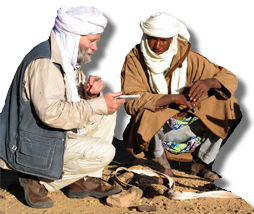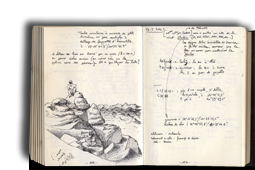Peintres du dimanche à la MINURSO
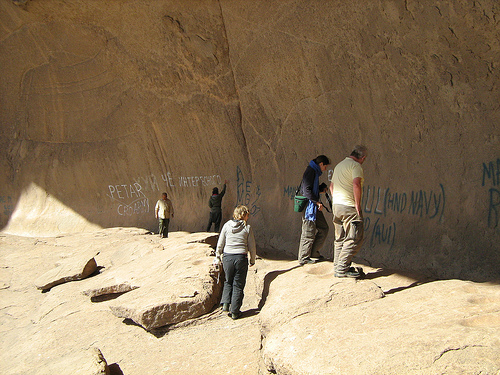
Les archéologues
constatent les dégâts commis dans l'un des abris
ornés de la région.
Plusieurs plaintes ont
été adressées, qui sont restées sans réponse, et
finalement, l'archéologue Nick Brooks, qui travaille
dans cette région, a rendu l'affaire publique en
mettant en ligne toute une série de photos de ces
dégradations et en en parlant sur son blog. Avec lui, on ne peut que
s'attrister de voir que les membres d'une
organisation des Nations Unies, ladite MINURSO,
saccagent impunément les mêmes sites
archéologiques que d'autres membres d'une autre
organisation des mêmes Nations Unies, ceux de
l'UNESCO, tentent d'inventorier et de sauvegarder!
Et Nick Brooks de conclure: "As long as UN
staff on the ground in Western Sahara delight in
defacing rock art, perhaps it is best not to
advertise its location." (tant que le
personnel des Nations Unies en poste au Sahara
Occidental se complaira à dégrader l'art rupestre,
il serait peut-être mieux de ne pas rendre
publique la localisation des sites). C'est certes
vrai, mais j'ajouterai que cela l'est pour
l'ensemble du Sahara, et même pour l'ensemble de
l'Afrique, où les dégradations et les pillages
vont bon train, parfois par suite du désoeuvrement
et du manque d'information, mais souvent aussi
pour des raisons mercantiles. Le mieux est donc de
ne signaler les sites archéologiques que par un
code hermétique aux non-initiés, suffisamment
précis pour travailler sur des SIG et produire des
cartes de répartition (des styles, des sujets,
etc.), tout en restant assez flou pour ne pas
permettre de retrouver facilement les sites sur le
terrain. Et à cet effet, donc, je renouvelle le
conseil d'utiliser ce système d'identification.
Pour l'heure, Nick Brooks a envoyé à la MINURSO (avec
copie à l'UNESCO) la plainte que je reproduis
ci-dessous. Sans réponse pour l'instant.
Dear Sir or Madam
I recently visited the southern sector of the
Polisario-controlled zone of Western Sahara in order
to conduct archaeological and palaeo-environmental
fieldwork. I was appalled to see that MINURSO
personnel have deliberately defaced an important
archaeological site at Lajuad, where they have
spray-painted their names and affiliations on the
face of a rockshelter housing vulnerable prehistoric
engravings and paintings. It appears that these
actions - actions that can only be called criminal -
were committed by MINURSO staff responsible for
installing communications equipment in June 2007. The
identities of the perpetrators should be clear from
the graffiti, a record of which I have published at
the following web link:
http://www.flickr.com/photos/western_sahara_project/sets/72157603491003320/
I have also publicised this destruction on my blog at
nickbrooks.wordpress.com, and will be circulating
details of this incident to colleagues in the
archaeological research and cultural heritage
communities.
The deliberate damage at Lajuad is not the only such
incidence of the defacing of rock art sites by
MINURSO personnel. I have seen similar damage at the
site of Rekeiz in the Northern Sector.
The only acceptable solution to the problem of
vandalism of these rock art sites by MINURSO
personnel is for MINURSO, the UN Department of
Peacekeeping Operations, or the countries whose staff
have committed these acts of vandalism to fund the
proper restoration of the damaged sites. It is also
imperative that MINURSO makes clear to all its staff
that such actions are completely unacceptable, and
that future such acts result in disciplinary action.
I do hope that MINURSO takes this matter seriously,
and addresses the acts of vandalism committed by its
personnel in an appropriate manner. As things stand
at present, MINURSO is undermining the work of
UNESCO, which I understand is about to embark on a
programme of recording of rock art sites in the
Polisario-controlled zone, the aim of which is to
help preserve the cultural heritage of Western Sahara
regardless of the ultimate outcome of the conflict
between Morocco and the Polisario. The archaeology of
Western Sahara is extremely important to our
understanding of African, and indeed global,
prehistory, and is at present virtually unknown to
the international research community - a matter that
I and others are currently attempting to address
through field-based research. It would be a tragedy
if this important global cultural resource was lost
as a result of ignorance and a lack of respect for
the territory's cultural heritage. It would be even
more tragic if this occurred at the hands of the
United Nations, which is meant to be working not only
towards a just and lasting peace in the region, but
also towards the preservation and understanding of
the world's cultural heritage.
Yours sincerely
Dr Nick Brooks
Director, Western Sahara Project:
www.cru.uea.ac.uk/~e118/wsahara.htm
Visiting Research Fellow
School of Environmental Sciences
University of East Anglia
Norwich NR4 7TJ
UK
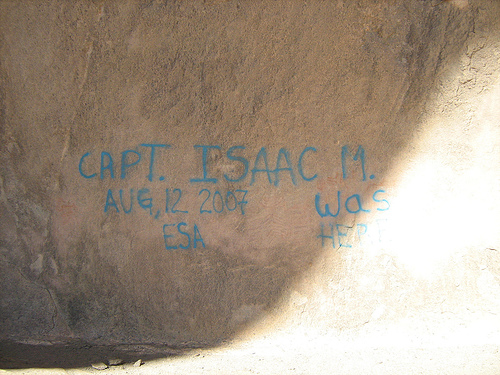
Le Capitaine Isaac fait partie de ces "missionnaires"
de la MINURSO qui ont absolument tenu à signaler à la
postérité
que ce sont bien eux qui ont dégradé les peintures
rupestres.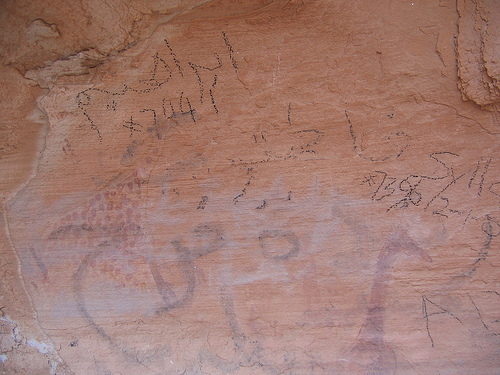
Ces girafes font partie des images rupestres
préhistoriques qui sont désormais à peine visibles
sous les graffiti.


